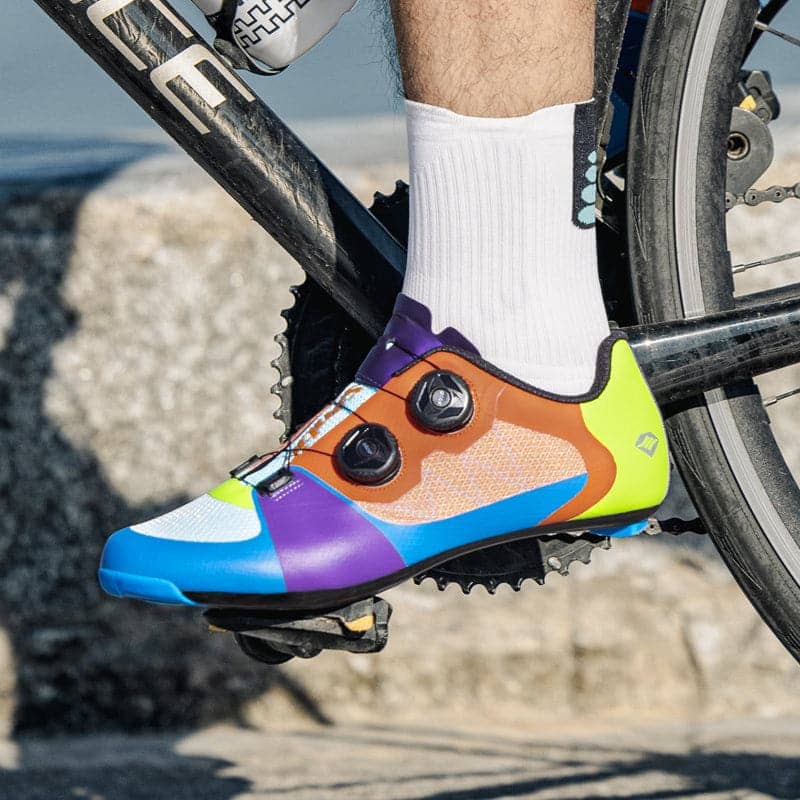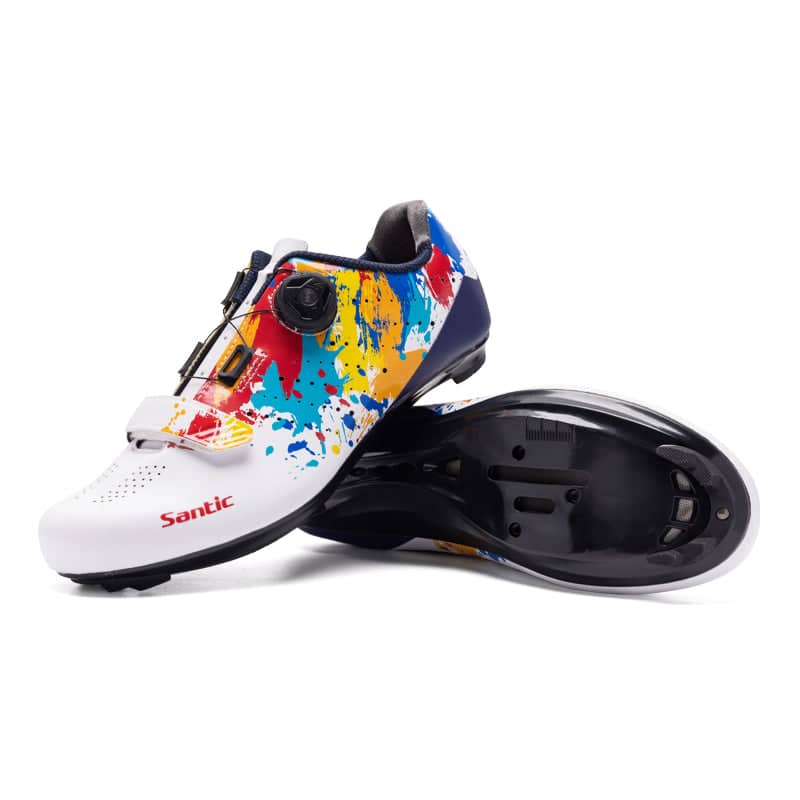Cycling Shoes For Beginners:The Ultimate Guide in 2024
Cycling shoes are designed to be light and rigid for effective pedaling, featuring mesh panels to keep your feet cool in the summer and a clipless pedal cleat compatible bottom.
In this guide, you’ll get in-depth information about the differences between athletic shoes and cycling shoes, the importance of choosing the right cycling shoes, road shoes, and MTB shoes. Read on to learn more!
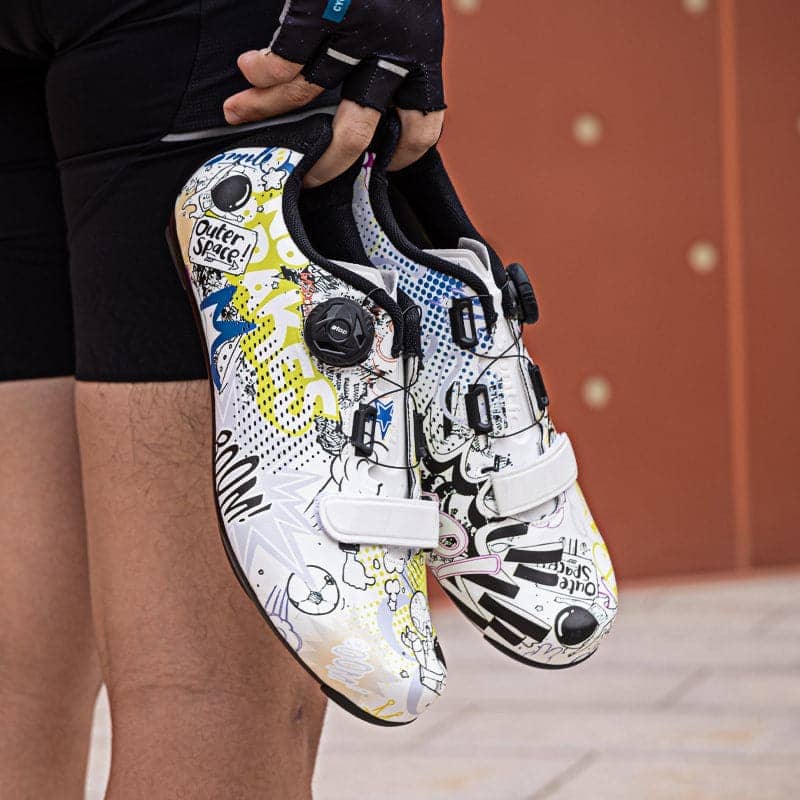
Typical athletic shoes vs cycling shoes
Athletic shoes, in general, feature a flexible and cushioned sole. They're also often light, allowing for a wide range of motion and making them ideal for sports like walking and jogging.
Cycling shoes, on the other hand, are more stiff, solid, and heavier. They also include cleats on the bottoms of the shoes that enable you to clip onto the pedals. The cleat is connected to a tougher sole, typically constructed of hard plastic, fiberglass, or carbon fiber. This ensures that the force of the stroke is distributed more evenly across the foot.
Importance of choosing the right cycling shoes
Cycling shoes are likely to be an essential piece of cycling equipment you possess. Riding shoes are not only fashionable but are also intended to improve riders' cycling experience. Of course, you may ride a bike in whatever shoes you choose, but anybody who rides regularly knows the advantages of well-constructed cycling shoes.
The benefits of using the proper bicycle shoes are as follows:
1. Bicycle pedaling efficiency
Cycling shoes have stronger bottoms than running shoes. When transferring push energy to pedals, less energy is wasted. The firm soles also provide more excellent foot protection when cycling and reduce tiredness and cramping.
2. Enhanced comfort
The soles of cycling shoes are rigid, but the uppers are constructed of breathable materials like mesh and well-designed vents that enable air to flow freely through the shoes when riding. Furthermore, cycling shoes produce virtually slight bending compared to other shoes, limiting the flexibility of movement on the feet when riding.
3. Reduced slipping
Running shoes provide a greater focus on pushing rather than pulling, putting a lot of strain on the quadriceps. Cycling shoes with SPD compatibility may be clipped onto clipless pedals (also known as SPD pedals) to prevent sliding while pedaling. Cycling shoes also take advantage of the energy efficiency of the push and draw of the pedals.
4. More Long-Lasting & Sturdy
Cycling shoes are constructed so that they may be worn for both light and heavy riding. The finish on the job is clean and excellent. Mesh and synthetic leather make up the upper. It can be used in both indoor cycling studios trainer and bicycle. Cycling shoes come with SPD/LOOK cleats, which are compatible with most indoor cycling studio trainers.

Major types of cycling shoes
The most common kinds of cycling shoes are listed below.
Road shoes
Road shoes feature lightweight construction, smooth outsoles, and good ventilation. They're characterized by their very firm soles, which aid power transmission to your pedals, making them an excellent choice for individuals seeking maximum performance. Road bike shoes are not suited for long walks because of their lack of grip on the soles, inability to bend, and usually protruding studs.
Clipless pedal-shoe combinations are used in road cycling shoes, with cleats at the bottom of the shoe's attaching to the pedals. A clipless pedal-shoe system provides better performance and economy because you transmit power while pulling up and down on pedals.
Three holes are usually drilled into the sole of road bike shoes to accommodate cleats and pedals from different manufacturers. While cycling, a 3-hole cleat system provides the greatest stability and energy transmission. The big cleat disperses the force exerted on the pedal across a broad region. When pedaling hard, this relieves strain on the connecting points and provides a solid connection.
MTB shoes
Because walking and dismounting are much more frequent than on the road, mountain bike shoes usually include a recessed cleat, greater tread, and a lugged outer sole. This mountain bike cleat also helps to drain dirt and debris that may accumulate when riding off-road. The stiffness and weight of the sole are essential, but not to the same extent as they are on a road shoe, since a mountain bike shoe must be much more flexible, taking into account walking, cleaning debris, comfort, and clipping in and out.
Mountain bike shoes, like road shoes, have a variety of closing methods. They will, however, usually have a separate 'upper' to prevent water penetration and a toe cover from guarding against dirt and obstructions. Mountain cyclists may choose between flat or clipless pedals. To help limit your options, consider the kind of riding you do, if you spend a lot of time off the bike, and other variables.
A two-bolt cleat system is used in clipless mountain bike shoes (SPD, crank brothers, or Time styles). Unlike road cycling shoes, mountain bike shoes include cleats that are usually recessed into the soles, making it simpler to walk on trails or elsewhere. They're great for cross-country, long-distance, and non-technical riding. On the other hand, mountain bike shoes may be preferred by specific road riders for their comfort and walkability.
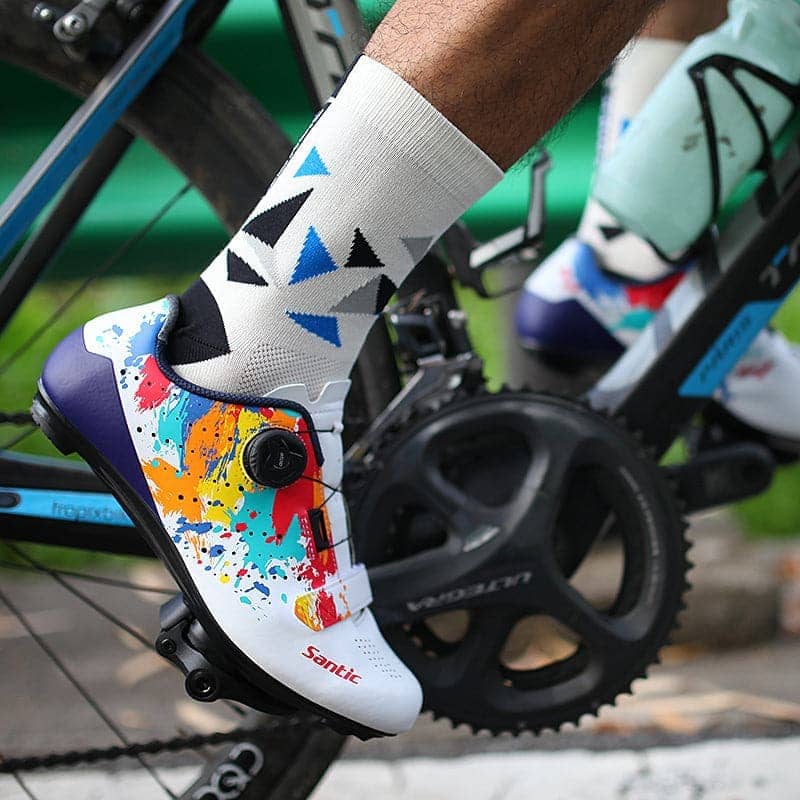
Spin Shoes
Spin shoes, which have clipless pedals and resemble sports shoes, are designed to be used inside. They're stiff but not as stiff as road shoes with a plastic-like sole that allows for a lot of flex for comfortable walking. They usually wear SPD-style cleats, which allow you to move about the home or gym without harming the floor.
Triathlon Cleats
In terms of stiffness and performance, triathlon shoes are similar to road cycling shoes, but there are a few significant distinctions. Triathlon cleats often feature a whole velcro closing system with a heel-loop, allowing for a faster transition while putting on and taking off the shoes. They are typically more cushioned to enable a barefoot ride and are more vented to let water escape. They're also clipless, with a rubber region on the heel and bumpers on the front and rear for when the athlete has to sprint.
Flat-soled/platform shoes
Casual bicycling shoes, such as flat-soled shoes, are ideal for novice cyclists (beginner cyclists). They feature a rubber outsole with a lot of traction, which keeps the foot from sliding off the pedal. The least stiff choice is usually flat-soled shoes, which results in a loss of power. On the other hand, Mountain cyclists may choose a completely flat bottom that allows for solid interaction with the pedal.
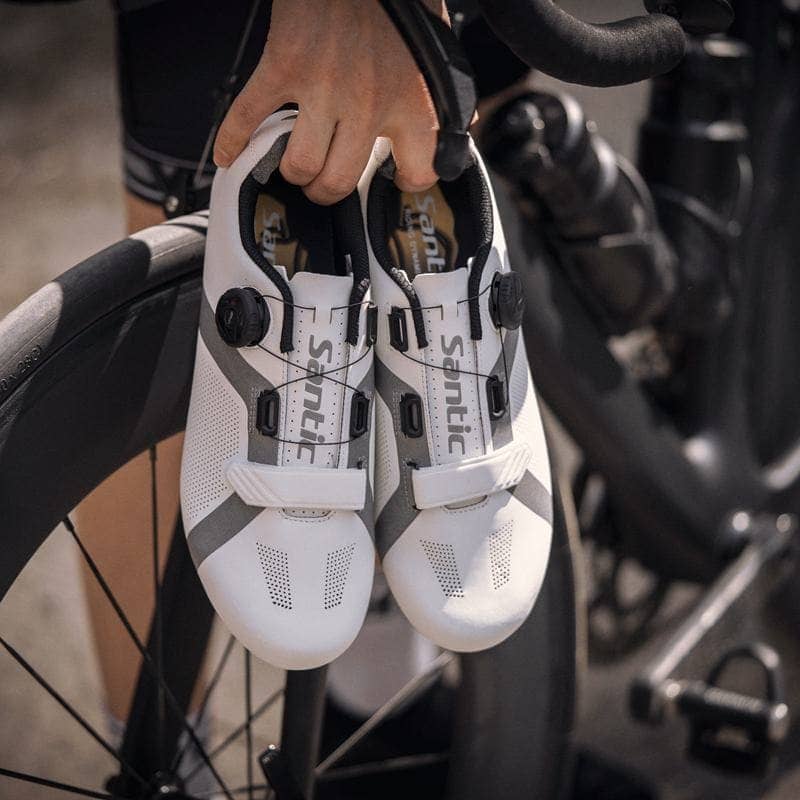
How to clip in and out of the pedals
Are you having trouble clipping in and out of your bike pedals? It's happened to all of us! That's why we've compiled this handy tutorial to teach you all you need to know about clipping into cycle bike pedals. Learn how to modify your clips to get the most out of your indoor riding experience!
Although there is nothing wrong with riding in your standard trainers, switching to cycling shoes will make your trip more comfortable, efficient, and safe. If this is your first time clipping in during a cycle bike exercise, ensure you have the proper pedals, shoes, and cleats for the task.
Follow these easy steps to clip in:
* Place your shoes on your feet and look for the ball of your foot. For optimum comfort, performance, and natural mobility in the ankles, the cycling cleat should be positioned precisely beneath the ball of the foot to produce a smooth pedal stroke and help avoid injury.
* Find the ideal toe-in or toe-out position. Make sure the cleats are placed such that you may toe in or out naturally. What do the terms "toe-in" and "toe-out" mean? When you connect your bicycle shoes to the pedals, these words describe how your feet are oriented. As you cycle, your feet should feel like they're pointed in the right way, with no discomfort or twisting in your hips, knees, or ankles.
* Make sure the cleats are positioned straight on the shoes as a good beginning point and evaluate how that feels.
Make sure that everything is secure. Ensure that the cleats are tightened as much as feasible. They should fit snugly against the shoe's sole and should not move or rotate while in place.
* Start gently by clipping in and peddling. Cycling shoes with cleats are changeable, but finding the ideal position on the bike may be tricky. We suggest clipping in and pedaling gently enough so the ball of your foot is in the middle of the bike pedal and your toe-in/out feels natural.
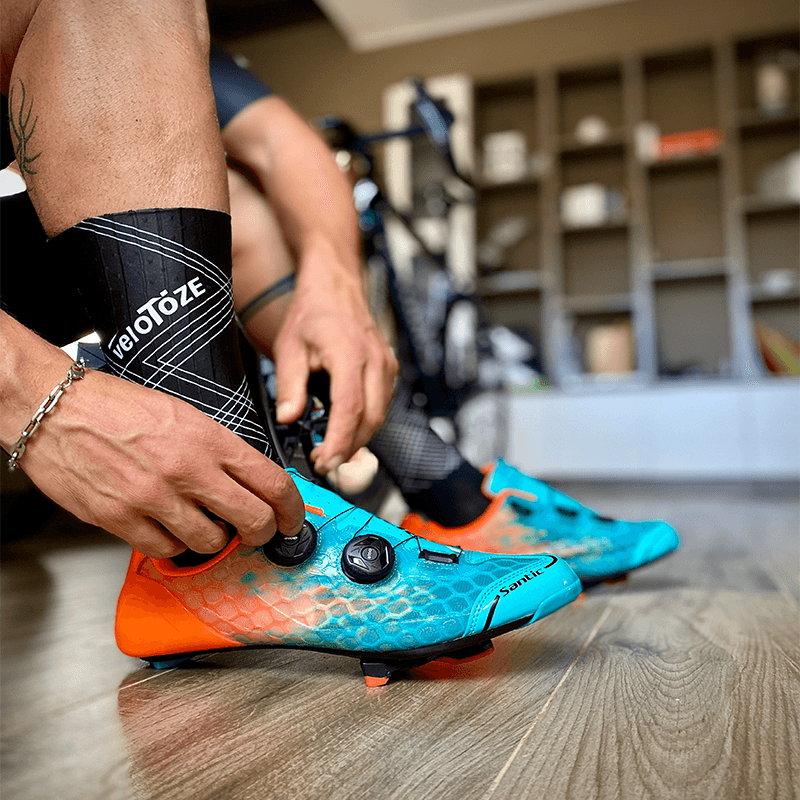
Conclusion
The bike itself isn't the only piece of equipment worth investing in, whether riding at home on a stationary bike or outside on a road or mountain bike. For a safer and more intensive riding experience, many bikes' pedals are intended to be used with a certain kind of clip, and that is where the cycling shoe comes in.
Cycling shoes are distinguished from regular shoes in two key respects. To begin with, they feature a firmer sole with little to no flexibility. Second, you may use these to clip cleats into your pedals.
Related Articles
【Best Cycling Shoes】
https://santic.com/blogs/extra/best-cycling-shoes
【Mountain Bike Shoes】
https://santic.com/blogs/extra/mountain-bike-shoes
【Cycling Shoes】
https://santic.com/blogs/extra/cycling-shoes
【Indoor Cycling Shoes Guide】
https://santic.com/blogs/extra/indoor-cycling-shoes-guide
【Cycling Helmets】
https://santic.com/blogs/extra/cycling-helmets
